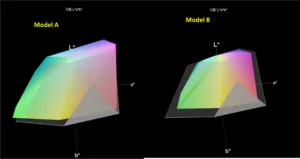Marcel Gonska from the SpectraCal division of Portrait Displays started his presentation by noting that professional monitors with different display technologies need slight different calibration procedures. RGB OLEDs for example, use a Judd modified white point, while LCD displays with RGB LED backlights and quantum dot displays may need some adjustment in the white point as well because of potential metamerism issues (the different perception of colors by different people because of the narrow RGB primaries).
He then talked about some of the pros and cons for using DCI-P3 and a BT.2020 color gamut in production. P3 is clearly a more practical solution today for a number of reasons, he concluded. Some professional display calibration tips were then offered.
Turning to consumer HDR calibration, he said the new CalMan software can handle HDR calibration, and SpectraCal is now offering a kit that includes a pattern generator and meter with the software all ready to go for HDR calibration. (for more see our forthcoming IBC report).
The rest of the presentation provided an overview on some of the HDR calibration features in CalMan 6. Gonska was also demonstrating the calibration potential in the associated demo area as well. CalMan does create color volume measurements using CIELAB and ICtCp methods, but there are no current standards for HDR color volume, although he noted that ICDM is working on this.
One of the new features available on Samsung TVs is AutoCal, which works with CalMan. This allows direct access to some of the menus in the TV to speed up the calibration process considerably and has been very well received so far.
Gonska also pointed out a related problem. All panels today are calibrated in the factory using a gamma EOTF. All the HDR processing is done prior to delivery to the gamma-based panel. He suggests creating a mode where calibrators can access the panel directly to calibrate the panel gamma, which will lead to better results for HDR calibration.

